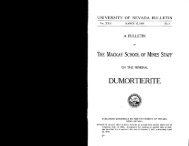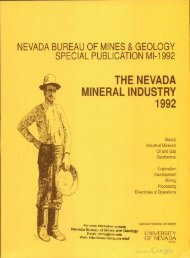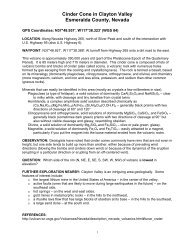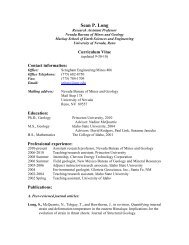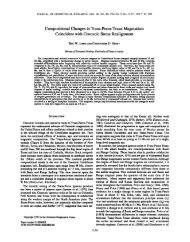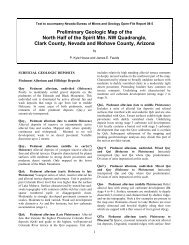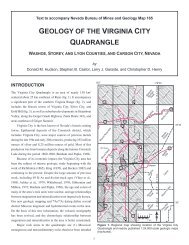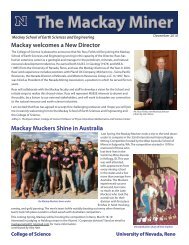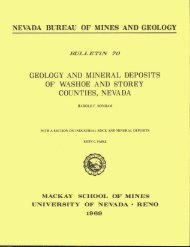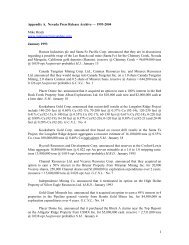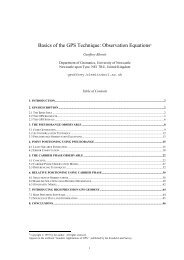Nevada Bureau of Mines and Geology - University of Nevada, Reno
Nevada Bureau of Mines and Geology - University of Nevada, Reno
Nevada Bureau of Mines and Geology - University of Nevada, Reno
You also want an ePaper? Increase the reach of your titles
YUMPU automatically turns print PDFs into web optimized ePapers that Google loves.
LOCATION<br />
GOLCONDA DISTRICT<br />
The Golconda mining district is generally centered on the town <strong>of</strong><br />
Golconda, located 27 km east <strong>of</strong> Winnemucca. The district is located<br />
adjacent to the west <strong>of</strong> the Iron Point mining district, <strong>and</strong> includes<br />
properties near Golconda Summit on U.S. Interstate 80, in the group <strong>of</strong><br />
hills south <strong>of</strong> the tom <strong>of</strong> Golconda, <strong>and</strong> at the extreme southern end <strong>of</strong><br />
the Osgood Mountains.<br />
HISTORY<br />
The district is named for the town <strong>and</strong> railroad station <strong>of</strong> Golconda.<br />
It was first known as Greggsville, for W.C. Gregg, who discovered <strong>and</strong><br />
organized the district in 1866 (Carlson, 1974). Gold was first discovered<br />
in 1866 on Kramer Hill (about 3 km southwest <strong>of</strong> the town) <strong>and</strong> minor<br />
amounts were produced through the early 1900's. The tungsten-manganese<br />
deposits about 5 km east <strong>of</strong> town were discovered at the same time; the<br />
deposits were an important source <strong>of</strong> tungsten from 1941 to 1945. A<br />
disseminated gold deposit (the Preble deposit) was discovered in 1972 in<br />
the southern Osgood Mountains, about 10 km northeast <strong>of</strong> the town <strong>of</strong><br />
Golconda. Mineral exploration for precious metals has been conducted on<br />
Kramer Hill <strong>and</strong> south <strong>of</strong> Golconda Summit. A small amount <strong>of</strong> bulk-mineable<br />
ore may have been developed at Kramer Hill.<br />
GEOLOGIC SETTING<br />
The Golconda mining district is almost entirely within the Golconda 7<br />
1/2-minute quadrangle. The geologic map <strong>of</strong> this quadrangle (Erickson <strong>and</strong><br />
Marsh, 1974) indicates that much <strong>of</strong> the bedrock exposure in the district<br />
consist <strong>of</strong> Cambrian to Permian sedimentary <strong>and</strong> volcanic rocks. The<br />
Cambrian rocks consist <strong>of</strong> quartzite, limestone, <strong>and</strong> siltstone.<br />
Pennsylvanian <strong>and</strong> Permian rocks are limestone <strong>and</strong> conglomerate deposited<br />
within the Antler highl<strong>and</strong> (see Stewart, 1980, p. 48), <strong>and</strong> siliceous <strong>and</strong><br />
volcanic eugeosynclinal rocks <strong>of</strong> the Pumpernickel Formation. These rock<br />
units are cut by Cretaceous dikes, sills, <strong>and</strong> small intrusive masses <strong>of</strong><br />
quartz diorite, quartz porphyry, <strong>and</strong> granodiorite. Mafic to<br />
intermediate-composition Tertiary volcanic rocks are present locally, but<br />
are usually unmineralized. Quaternary hot spring deposits (travertine)<br />
containing tungsten <strong>and</strong> manganese are present near the range front east <strong>of</strong><br />
Golconda.<br />
ORE DEPOSITS .<br />
The major production from the district has been 83,739 units (20<br />
pounds each) <strong>of</strong> WO from 105,591 tons <strong>of</strong> ore between 1941 <strong>and</strong> 1945 (White,<br />
3<br />
1955, p. 135). Tungsten-manganese deposits occur in ferruginous <strong>and</strong><br />
manganiferous clay beds in Pleistocene alluvial gravels that rest on<br />
Cambrian Preble Formation. The Preble consists primarily <strong>of</strong> phyllitic<br />
Golconda District - 1



